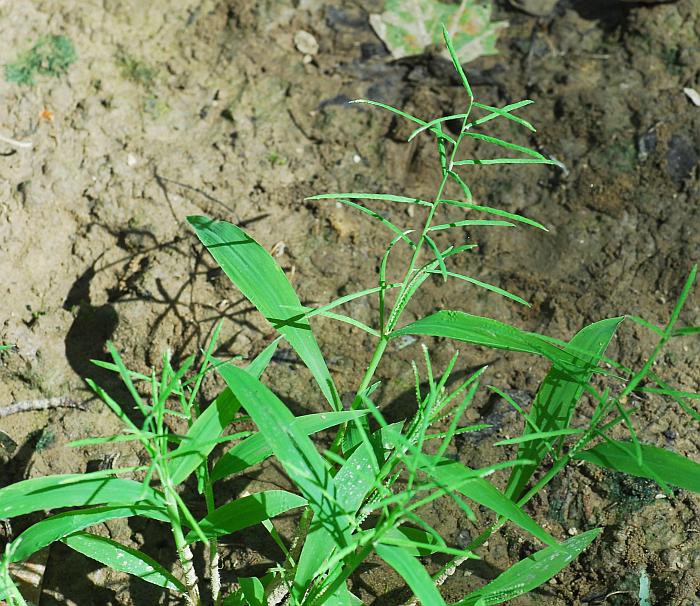Paspalum repens P.J. Bergius
Horsetail Paspalum

Native
CC = 5
CW = -5
MOC = 32
© SRTurner
Paspalum repens P.J. BergiusHorsetail Paspalum | |
 |
Native CC = 5 CW = -5 MOC = 32 |
© SRTurner |
|
Family - Poaceae/Paniceae Habit - Annual grass, forming mats or tufts, with C4 metabolism.
Stems - Flowering stems spreading to weakly erect or decumbent, to 1.0 m, often thick and somewhat succulent, often rooting at the nodes, usually with several to many branches near the base.
Leaves - Leaf sheaths often somewhat inflated, glabrous or hairy, the ligule 1.0-2.2 mm long. Leaf blades 3-25 cm long, 3-15 mm wide, glabrous or roughened, sometimes also sparsely hairy near the base.
Inflorescences - Terminal panicles with 5-50 spikelike branches alternate to opposite to whorled near the base, densely spaced and less than 1 cm apart along the main axis. Spikelike branches 2-6 cm long, ascending to spreading, the axis shed eventually after fruiting, extended past the uppermost spikelet into a short, pointed, sterile tip, relatively broad, leaflike or winged, wider than the spikelets and with the margins sometimes somewhat wrapped around them, the spikelets dense and mostly strongly overlapping along the axis, mostly single and appearing in 2 rows.
Spikelets - 1.1-1.7 mm long, elliptic in outline, sharply pointed at the tip. Lower glume absent. Upper glume 1.1-1.7 mm long, elliptic, sharply pointed at the tip, 2-nerved near the margins, finely hairy. Sterile floret with the lemma 1.1-1.7 mm long, elliptic, sharply pointed at the tip, 2-nerved near the margins, finely hairy. Fertile floret with the lemma 1.1-1.6 mm long, elliptic. Anthers 0.2-0.4 mm long.
Fruits - Caryopses, broadly oblong-elliptic in outline. Flowering - July - October. Habitat - Swamps, bottomland forests, sloughs, streambanks, pond margins, ditches; usually emergent aquatics. Origin - Native to the U.S. Lookalikes - None close. Fancifully, horsetails (Equisetum arvense). Other info. - This interesting little species of Paspalum masquerades as something else. Its inflorescence branches are widely winged, making the spikelets invisible from above. In this manner the plant can faintly resemble a horsetail. A glance underneath will reveal the neat rows of spikelets, and the plant's numerous inflorescence branches complete the identification. It is found in a number of counties scattered in various parts of Missouri, and southward to the Gulf Coast. It prefers very wet conditions, and a good place to search for it is along muddy banks of sloughs and rivers. Photographs taken at Tyson County Park, St. Louis County, MO, 8-23-2021 (SRTurner). |